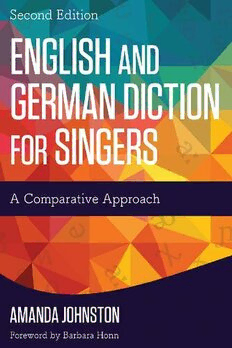
English and German Diction for Singers: A Comparative Approach PDF
Preview English and German Diction for Singers: A Comparative Approach
English and German Diction for Singers English and German Diction for Singers A Comparative Approach Second Edition Amanda Johnston ROWMAN & LITTLEFIELD Lanham • Boulder • New York • London Published by Rowman & Littlefield A wholly owned subsidiary of The Rowman & Littlefield Publishing Group, Inc. 4501 Forbes Boulevard, Suite 200, Lanham, Maryland 20706 www.rowman.com Unit A, Whitacre Mews, 26-34 Stannary Street, London SE11 4AB Copyright © 2016 by Amanda Johnston All rights reserved. No part of this book may be reproduced in any form or by any electronic or mechanical means, including information storage and retrieval systems, without written permission from the publisher, except by a reviewer who may quote passages in a review. British Library Cataloguing in Publication Information Available Library of Congress Cataloging-in-Publication Data Names: Johnston, Amanda, 1971- Title: English and German diction for singers : a comparative approach / Amanda Johnston. Description: Second edition. | Lanham, Maryland : Rowman & Littlefield, [2016] | Includes bibliographical references and index. Identifiers: LCCN 2016018359 (print) | LCCN 2016018532 (ebook) | ISBN 9781442260887 (cloth : alk. paper) | ISBN 9781442260894 (pbk. : alk. paper) | ISBN 9781442260900 (electronic) Subjects: LCSH: Singing--Diction. | English language--Pronunciation. | German language--Pronunciation. Classification: LCC MT883 .J64 2016 (print) | LCC MT883 (ebook) | DDC 783/.043--dc23 LC record available at https://lccn.loc.gov/2016018359 The paper used in this publication meets the minimum requirements of American National Standard for Information Sciences—Permanence of Paper for Printed Library Materials, ANSI/NISO Z39.48-1992. Printed in the United States of America To my students, who continue to challenge and inspire me Contents Musical Examples xiii Foreword xv Preface xix PART I: INTRODUCTION 1 Chapter 1: Elementary Concepts 3 1.1 Phonetics and the International Phonetic Alphabet 3 1.2 Vowel classification 4 1.3 Consonant classification 5 1.4 Organs of speech 7 1.5 Points of articulation 8 Chapter 2: Proficiency in English IPA 9 2.1 Vowels 9 2.2 Diphthongs 13 2.3 Triphthongs 16 2.4 Consonants 16 Chapter 3: Proficiency in German IPA 25 3.1 Vowels 25 3.2 Diphthongs 29 3.3 Consonants 30 PART II: ENGLISH 37 Chapter 4: Introduction to English Diction for Singers 39 4.1 Challenges of singing in English 39 vii viii Contents 4.2 Dialect and accent: General American English (GA) 41 and Received Pronunciation (RP) 4.3 Challenges of singing musical theatre repertoire 43 Chapter 5: English Phonemes 45 Chapter 6: The Structure of English 53 6.1 Syllabification: sung vs. spoken 53 6.2 Word stress and “unstress” 55 6.3 Glottal attacks or onsets 58 6.4 Silent letters 61 6.5 Homophones 62 6.6 Contractions 64 Chapter 7: Characteristic English Phonemes 65 7.1 Use of [ɑ] and [æ], but absence of [a] 65 7.2 Importance of the schwa [ə] 65 7.3 Use of Y 67 7.4 Allophones of R: [ɾ][ɹ][r] 68 Chapter 8: Vowels 73 8.1 Monophthongs 73 8.2 Diphthongs 87 8.3 Triphthongs 93 Chapter 9: Glides and Approximants 95 9.1 Use of [w] and [ʍ] 95 9.2 Use of [j] 97 9.3 Use of retroflex R: [ɹ] 99 Chapter 10: Consonants 103 10.1 Efficiency in production 103 10.2 Voiced vs. voiceless 104 10.3 Double consonants 108 10.4 Individual consonants 108 10.5 Consonant blends 125 Chapter 11: Advanced Concepts in Diction 127 Contents ix 11.1 Treatment of monosyllabic incidental words 127 11.2 Strong and weak forms of incidental words 129 11.3 Implosion/explosion 131 11.4 Unstressed syllables: use of [ɪ] in prefixes 134 11.5 Grammatical ending: -ed 135 Chapter 12: Common Pitfalls 137 12.1 Improper word stress 137 12.2 Influence of spoken regionalisms 138 12.3 Influence of mother tongue 139 12.4 Common mispronunciations 140 12.5 Influence of speech habits 141 PART III: GERMAN 145 Chapter 13: Introduction to German Diction for Singers 147 13.1 Hochdeutsch and Bühnendeutsch 147 13.2 Reference books 148 13.3 Neue Rechtschreibung 148 13.4 Orthographic features: Umlaut and Eszett (ß) 149 Chapter 14: German Phonemes 151 Chapter 15: The Structure of German 155 15.1 Root system and word structure 155 15.2 Grammatical and inflectional endings 157 15.3 Prefixes and suffixes 159 15.4 Compound words 166 15.5 Word origin and loan words 168 15.6 Glottal attacks or onsets 169 Chapter 16: Characteristic German Phonemes 171 16.1 The ich-laut [ç], ach-laut [χ], and Curly-tail J [ʝ] 171 16.2 Use of R: [ɾ] vs. [ɐ] 177 16.3 The German schwa: vocalic chameleon 182 Chapter 17: Vowels 185
